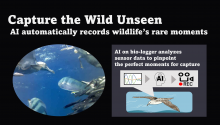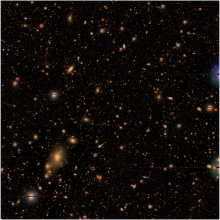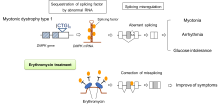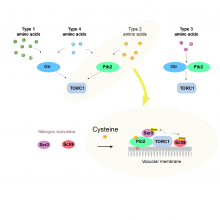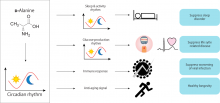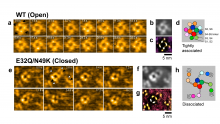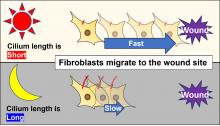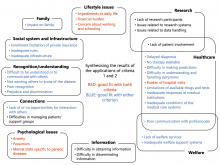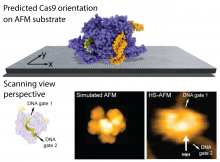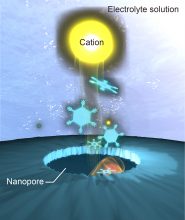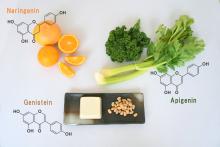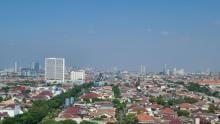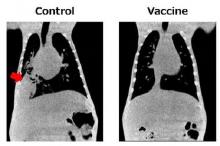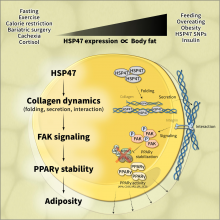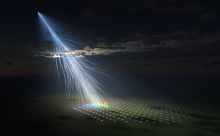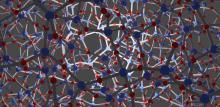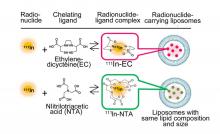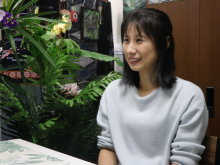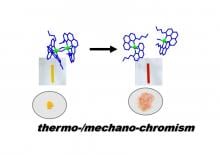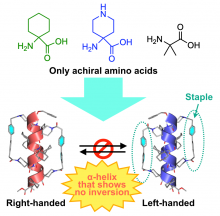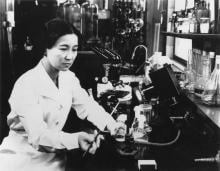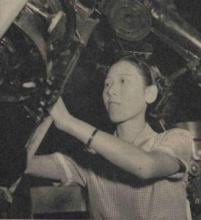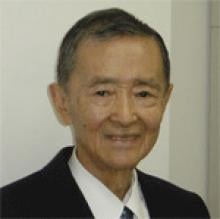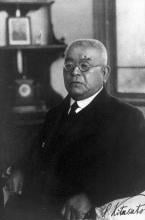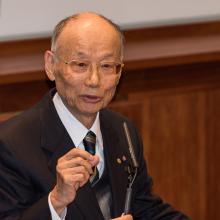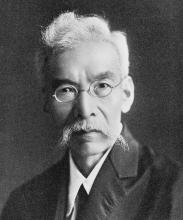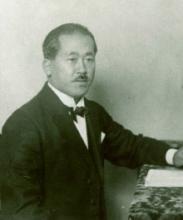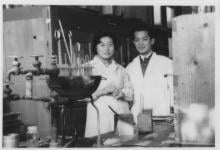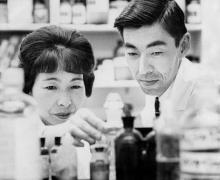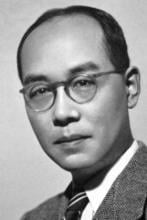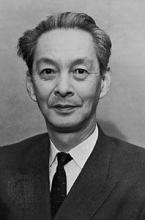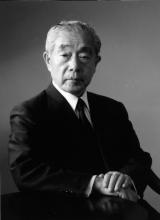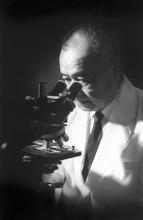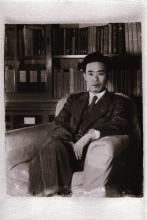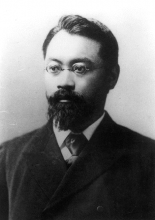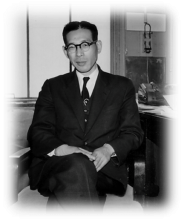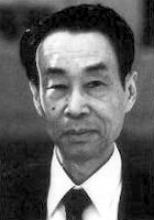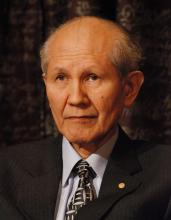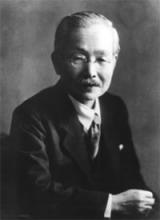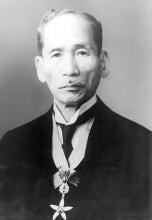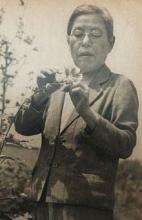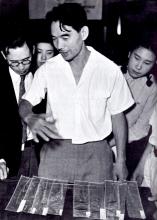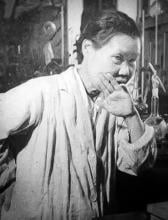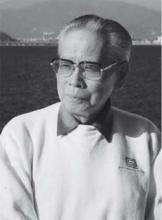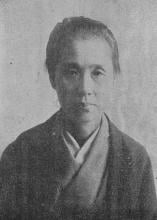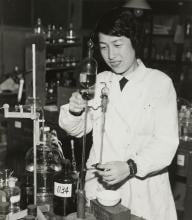Japan
News
22 Dec 2023
Researchers from Osaka University developed a bio-logger for seabirds that enables long-term observation of rare behaviors. The bio-logger employs low-power depth sensors and accelerometers to identify rare behavior using a light-weight outlier detection model and records the behavior in a 5-min video. Observations using the bio-loggers on Streaked Shearwaters revealed novel aspects of head-shaking and foraging strategies. This approach will enable a wider range of animal behaviors in various environments to be observed.
21 Dec 2023
Kavi IPMU researchers have analyzed more than one million galaxies to explore primordial fluctuations that seeded the formation of the structure of the entire universe.
21 Dec 2023
A research group led by Osaka University and University of Hawaii Manoa found that in female fruit flies, microorganisms enhance reproductive function, boosting the number of cells that form eggs and the number of mature eggs. This is done by controlling the release of hormones to speed up cell division in the ovaries, and limiting programmed cell death. These findings could improve reproductive medicine and could aid the development of new methods to enhance fertility.
21 Dec 2023
A team of researchers has developed an innovative method to design complicated all-α proteins, characterized by their non-uniformly arranged α-helices as seen in hemoglobin. Employing their novel approach, the team successfully created five unique all-α protein structures, each distinguished by their complicated arrangements of α-helices. This capability holds immense potential in designing functional proteins.
21 Dec 2023
In a phase 2 trial, researchers from Osaka University have found that erythromycin, a commonly used antibiotic, has acceptable safety and tolerability profiles in patients with myotonic dystrophy type 1. This common form of muscular dystrophy currently has no cure, and the research team is hopeful that phase 2b and 3 trials will further reveal the efficacy of erythromycin as a treatment—at least in some patients.
21 Dec 2023
Researchers from Osaka University have discovered how amino acids activate a key cell, TORC1, which is a master regulator in living organisms that controls whether cells grow or recycle their contents in yeast. Notably, the team found that the amino acid cysteine is sensed by a protein called Pib2 and that the two bind together to trigger TORC1. This is important because faulty TORC1 has been linked to disease such as cancer.
21 Dec 2023
Researchers from Osaka University have shown that the rare D-form of the amino acid alanine shows a clear circadian rhythm, and is able to affect the circadian clock and regulate gluconeogenesis, a method of glucose release, in the kidney. D-alanine upregulates genes linked to both gluconeogenesis and the circadian rhythm through the circadian transcriptional network. D-alanine is linked to many metabolic and immunological diseases, and this mechanistic insight could potentially lead to novel therapeutic approaches.
20 Dec 2023
Researchers at Nano Life Science Institute (WPI-NanoLSI), Kanazawa University report in Nature Communications a high-speed atomic force microscopy study of the structural dynamics of sodium ion channels in cell membranes. The findings provide insights into the mechanism behind the generation of cell-membrane action potentials.
20 Dec 2023
We’re all familiar with our body’s internal clock: it gives us cues on when to wake and when to rest, but it also can determine the rate and time of day at which your body most effectively heals wounds.
13 Dec 2023
A previously mysterious small RNA molecule in mice is found to play a crucial role in gene expression, and may be the first identified member of a new class of regulatory RNAs.
13 Dec 2023
Scientists at Osaka Metropolitan University have developed an efficient, non-invasive, and pain-free method to generate canine-induced pluripotent stem cells (iPSCs). They identified six reprogramming genes that can boost canine iPSC generation by 120 times compared to conventional methods using fibroblasts. The iPSCs were created from urine-derived cells without the need for feeder cells, an impossible feat until now. Their findings are expected to advance regenerative medicine and genetic disease research in veterinary medicine.
12 Dec 2023
Researchers from Osaka University created an online space for conversation, collaboration and knowledge sharing among patients with rare diseases, their families, researchers and policymakers. A series of workshops generated evidence that could contribute to new policies in the field of rare diseases and explore ways that stakeholders could be involved in the process.
12 Dec 2023
Researchers from Osaka University and collaborating partners have developed a new means of manipulating Mie scattering from nanostructures. By judicious choice of the laser illumination position with respect to the center of a nanostructure, one can strongly enhance optical responses that would not have been otherwise possible. This work is an important milestone in modern meta-photonics and will benefit computing and communication technologies.
08 Dec 2023
Researchers at Kanazawa University report in Frontiers in Molecular Biosciences a computational method to predict the placement of proteins on AFM substrates based on electrostatic interactions.
08 Dec 2023
Researchers from Osaka University investigated the thermal energy changes across nanopores that allow the selective flow of ions. Switching off the flow of ions in one direction led to a cooling effect. The findings have applications in nanofluidic devices and provide insight into the factors governing ion channels in cells. The nanopore material could be tailored to tune the cooling and arrays could be produced to scale up the effect.
07 Dec 2023
A research team led by Osaka Metropolitan University focused on generative AI as an information-gathering tool in the medical field. The results showed that one of the generative AIs suggested mostly fictitious references, while the other suggested multiple references with the same level of accuracy as the researchers. The use of generative AI in literature search suggests the possibility of efficiently collecting a vast amount of medical information, provided that users are well aware that the performance of generative AI is still in its infancy and that not all information presented is necessarily reliable. It is advised to use different generative AIs depending on the type of information needed.
30 Nov 2023
An international team of researchers led by Osaka Metropolitan University has elucidated the process by which the major flavonoids naringenin, apigenin, and genistein are metabolized in the body. These findings are fundamental in elucidating the correlation between the metabolism of flavonoids in the body and their potential health benefits.
30 Nov 2023
A new bacterial species discovered at the deep-sea hydrothermal vent site ‘Crab Spa’ provides a deeper understanding of bacterial evolution.
30 Nov 2023
Aids local governments in adapting to the threats of climate change
29 Nov 2023
Researchers at Kanazawa University report in Science Advances how they can accelerate and decelerate chirality inversion in large cage molecules using alkali metal ion binding.
27 Nov 2023
A research team from Osaka Metropolitan University has successfully developed a novel pneumococcal vaccine by combining the team’s proprietary mucosal vaccine technology with pneumococcal surface proteins that can cover a wide range of serotypes. Experiments were conducted using mice and macaques and it was confirmed that pneumonia caused by pneumococcal infection was clearly suppressed in the target groups of animals inoculated with the vaccine.
27 Nov 2023
Researchers from Osaka University found that HSP47, a collagen-specific chaperone, is a key determinant of body fat levels. HSP47 expression levels are upregulated with obesity and greater food intake and decreased with fasting, exercise, calorie restriction, bariatric surgery, and wasting syndrome, suggesting that HSP47 modulation has a profound effect on fat storage.
22 Nov 2023
Osaka Metropolitan University researchers and their colleagues have successfully detected an ultra-high-energy cosmic ray with an energy level comparable to the most energetic cosmic ray ever observed. The cosmic ray is set to be named after the Japanese sun goddess, Amaterasu. No promising astronomical object has been identified in the direction from which this cosmic ray originated, implying the potential existence of unknown astronomical phenomena and novel physical origins beyond the Standard Model.
21 Nov 2023
Researchers from Osaka University have shown that lysosomes, key organelles for maintaining cellular stability, can be repaired once damaged by a process termed microautophagy. They identified molecules called STK38 and GABARAPs as key regulators of this process. Depletion of microautophagy regulators lead to increased cellular senescence and a shorter lifespan, indicating the importance of this process. This study is highly significant for the achievement of healthy aging and points toward new therapies for age-related diseases.
21 Nov 2023
Glass is a fundamental material. Yet its atomic structure still baffles scientists to this day. Researchers have developed a new way to quantify ring shapes in chemically bonded networks of glass, chipping away at some of the mysteries behind glass’s atomic structure.
21 Nov 2023
Researchers develop new method suppressing the distribution of drugs to healthy tissues, but also to rapidly removes the drugs once distributed in the body, which could improve the accuracy of imaging diagnosis of difficult cancers, reduce toxicity to healthy tissues, and furthermore improve the effectiveness of treatment.
21 Nov 2023
Out of this living laboratory emerged unexpected insights on coexistence from an “unusual” source.
20 Nov 2023
This paper highlights the underexplored potential of chiral self-sorting in the design of switchable and metastable discrete supramolecular structures.
17 Nov 2023
Researchers at Kanazawa University report in Nature Communications how they can control chirality inversion in α helical peptides.
17 Nov 2023
Rapid preparation and application of a panel of clinical antibodies armed with B-BiTE for refractory malignancies
Events

25 Mar 2010
Three experts of IP & Technology Transfer in the forefront medical field, such as regenerative medicine are invited from US. What are challenges and problems typical in this field? What’s the strategy of prosecution and commercialization in this field? Speech and discussion are expected.

09 Mar 2010
International Symposium "Let's Talk About Infrahuman Intelligence" is to be held as follows.
* Admission free, no registration required.
*This event will be held in English; no interpretation provided.

05 Mar 2010
International Symposium on Designing Governance for Civil Society

04 Mar 2010
As a part of the Project for Establishing Core Universities for Internationalization (Global 30), the Faculty of Environment and Information Studies will launch a new program named “Global Information and Communication Technology and Governance Academic (GIGA) Program” in September 2011.

18 Feb 2010
Keio Media Design launches an information session at New York!

18 Feb 2010
RIKEN will be hosting a booth at the 2010 Annual Meeting of the American Association for the Advancement of Science (AAAS), to be held in San Diego, Feb. 18-22. The AAAS is a global organization dedicated to advancing science around the world.

11 Jan 2010
The objective of the RIKEN Conference is to advance the physical, chemical, biological, medical, and engineering sciences and to promote practical application in these disciplines, as well as to provide an international interdisciplinary forum for discussion among scientists.

12 Jan 2010
JUNBA (Japanese University Network in the Bay Area) will hold its Symposium and Technology Fair on Tuesday, January 12th, 2010.

30 Jan 2010
International GCOE Symposium on Neurocognitive Development "Shedding Light on Developing Brain" is to be held as follows.
*Admission free, registration is required.
*This event will be held in English; no interpretation will be provided.

08 Dec 2009
Time & Date: Tuesday 8th December 2009, 13:00 – 16:30
(Registration starts at 12:30)
Venue: 2 Fl, Conference Hall, Old University Library, Keio University Mita Campus
Admission Free - Advance registration essential (See below)

14 Dec 2009
The increasingly complex and interconnected world in which we live poses broad new challenges for science and society. Among the most important are global climate change, clean energy, population growth, sustainable food and water supplies, and the development of effective social organizations on both local and global scales.

14 Dec 2009
International Symposium on Complex Systems "Toward Sustainable Social Systems: Phase transition - Evolution - Polysemy" is to be held as follows.
* Admission free, Online registration is required.(Deadline: Friday, 11th December, 2009)
*This event will be held in English; no interpretation will be provided.

11 Dec 2009
Date December 11th (Fri) 2009, 10:00-17:00
Venue Tokyo International Forum - Hall B7 and Hall B5
Admission Free of charge (Reservation is not necessary.)
Organizer Keio Leading-edge Laboratory of Science and Technology [KLL]
(Keio University Faculty of Science and Technology / Graduate School of Science and Technology)

13 Dec 2009
Keio Media Design launches an information session at Malaysia (KL)!

11 Dec 2009
Keio Media Design launches an information session at National University of Singapore (NUS)!

30 Oct 2009
The Public Role of Higher Education in a Changing Global Environment
Multi-polar initiatives through Linkages and Dialogues

06 Nov 2009
Keio Symposium Mexico and Japan: Opportunities to Enhance Regional Competitiveness in Asia Pacific on November 6

12 Mar 2010
The Tokyo Conference on Psycholinguistics welcomes papers that represent any scientific endeavor that addresses itself to “Plato’s Problem” concerning language acquisition: “How we can gain a rich linguistic system given our fragmentary and impoverished experience?”

28 May 2009
Please join us for exploring KMD and discussing with our distinct faculty members for your learning opportunity.

13 May 2009
International Symposium Presented by Waseda University Organization for Japan-US Studies Research Group “International Cooperation”

06 Apr 2009
On the occasion of the 110th anniversary of the establishment of diplomatic relations between Greece and Japan, an exhibition of subway art from Athens will open at the Tokyo National Museum on April 7, preceded by a symposium at Keio University on April 6, 2009.

19 Dec 2008
The theme of this year's exhibition, "Innovative frontiers dreams" allows visitors to view the fruits in science and technology nurtured by Keio University - celebrating the 150th anniversary of our founding - while at the same time getting a sense of the University's future hopes.

22 Nov 2008
This is a revolutionary Okinawan exhibition that introduces works such as modern Okinawan art and photography.

18 Dec 2008
This year marks the 100th anniversary of the birth of Herbert von Karajan, and a variety of commemorative events are being held throughout the world. The Waseda Symphony Orchestra, which possesses deep relationship with Karajan, is part of commemorative events to celebrate this distinguished man.

21 Nov 2008
Keio Digital Archive Research Center and King's College Centre for Computing in the Humanities Conference

05 Dec 2008
The troubles in US subprime lending that began in 2007 proved to be a catalyst to failures of gigantic financial services companies around the world. To understand the present world business, we are starting a series of global business seminars, first with INDIA.

07 Nov 2008
A ceremony to commemorate Keio University's 150th anniversary will be held at the Hiyoshi Campus on Saturday, November 8, 2008. The occasion will be attended by some 10 000 people, including alumni, students, and guests from Japan and abroad.

07 Nov 2008
A Japanese Takigi Noh Performance will be held at Keio University as part of the 150th Anniversary celebrations.

07 Nov 2008
Invited speakers from China, Korea, the UK, and the US will discuss "The Future of Asia" and Keio University's role in the future of higher education in Japan, Asia, and the world.
Researchers
Sorry, no researchers coming up for this topic.
Giants in history
Ruby Sakae Hirose (1904 – 1960) was a Japanese-American scientist whose research contributed significantly to our understanding of blood clotting, allergies and cancer.
Haisako Koyama (1916 – 1997) was a Japanese solar observer whose dedication to recording sunspots – cooler parts of the sun’s surface that appear dark – produced a sunspot record of historic importance.
Michiaki Takahashi (17 February 1928 – 16 December 2013) was a Japanese virologist who developed the first chickenpox vaccine.
Toshiko Yuasa (11 December 1909 – 1 February 1980) was the first Japanese female physicist whose research on radioactivity shed light on beta decay – the process in which an atom emits a beta particle (electron) and turns into a different element.
Baron Kitasato Shibasaburo (29 January 1856 – 13 June 1931) was a Japanese physician and bacteriologist whose work led to a new understanding of preventing and treating tetanus, diphtheria and anthrax.
By isolating soil microorganisms and studying the compounds they produce, Satoshi Omura (born 1935) discovered almost 500 organic compounds with unique properties that were produced by these microorganisms, including many new antibiotics.
In 1915, pathologist Katsusaburo Yamagiwa and his research assistant Koichi Ichikawa became the first to prove that chronic exposure to chemicals can cause cancer.
In 1915, Koichi Ichikawa along with pathologist Katsusaburo Yamagiwa became the first to prove that chronic exposure to chemicals can cause cancer.
Reiji Okazaki (8 October 1930 – 1 August 1975) and Tsuneko (7 June 1933) were a Japanese couple who discovered Okazaki fragments – short sequences of DNA that are synthesized during DNA replication and linked together to form a continuous strand.
Tsuneko (7 June 1933) and Reiji Okazaki (8 October 1930 – 1 August 1975) were a Japanese couple who discovered Okazaki fragments – short sequences of DNA that are synthesized during DNA replication and linked together to form a continuous strand.
Husband and wife team, Kimishige (3 December 1925 – 6 July 2018) and Teruko Ishizaka (28 September 1926 – 4 June 2019) discovered the antibody class Immunoglobulin E (IgE) that triggers allergic reactions. They also discovered that IgE antibodies attach to white blood cells, known as mast cells, releasing histamine, which causes allergic reactions.
Husband and wife team, Kimishige (3 December 1925 – 6 July 2018) and Teruko Ishizaka (28 September 1926 – 4 June 2019) discovered the antibody class Immunoglobulin E (IgE) that triggers allergic reactions. They also discovered that IgE antibodies attach to white blood cells, known as mast cells, releasing histamine, which causes allergic reactions.
Japanese chemist Takamine Jokichi (3 November 1854 – 22 July 1922) founded the Tokyo Artificial Fertilizer Company, where he isolated a starch-digesting enzyme (named takadiastase) from the fungus Aspergillus oryzae.
Hideki Yukawa (23 January 1907 – 8 September 1981) was awarded the Nobel Prize in Physics in 1949 for predicting the existence of the pi meson subatomic particle. Japan’s first Nobel laureate, Yakawa also expressed his support for nuclear disarmament by signing the Russell–Einstein Manifesto in 1955.
Shinichiro Tomonaga (31 March 1906 – 8 July 1979), together with Richard Feynman and Julian Schwinger, was awarded the Nobel Prize in Physics in 1965, for their contributions to advance the field of quantum electrodynamics. Tomonaga was also a strong proponent of peace, who actively campaigned against the proliferation of nuclear weapons and promoted the peaceful use of nuclear energy.
Japanese chemist Kenichi Fukui (4 October 1918 – 9 January 1998) was the first Asian scientist to be awarded the Nobel Prize in Chemistry. Together with Roald Hoffman, he received this honour in 1981 for his independent research into the mechanisms of chemical reactions.
Minoru Shirota (April 23, 1899 – March 10, 1982) was a Japanese microbiologist who invented the popular fermented drink Yakult.
Japanese physicist Ukichiro Nakaya (1900-1962) made the world’s first artificial snowflakes. He started his research on snow crystals in the early 1930s at Hokkaido University, where there is an unlimited supply of natural snow in winter. By taking over 3,000 photographs, he established a classification of natural snow crystals and described their relationship with weather conditions.
The techniques that make industrial pearl culturing possible were developed over a century ago at the Misaki Marine Biological Station in Japan. The station’s first director, Professor Kakichi Mitsukuri, emphasized to Kokichi Mikimoto in 1890 that stimulating pearl sac formation was important for pearl growth, and they went on to successfully develop methods for culturing pearls.
The field of solid-state ionics originated in Europe, but Takehiko Takahashi of Nagoya University in Japan was the first to coin the term ‘solid ionics’ in 1967. ‘Solid-state ionics’ first appeared in 1971 in another of his papers, and was likely a play on ‘solid-state electronics’, another rapidly growing field at the time.
Chika Kuroda (24 March 1884 – 8 November 1968) was a Japanese chemist whose research focussed on the structures of natural pigments.
Motoo Kimura (13 November 1924 – 13 November 1994) was a Japanese theoretical population geneticist who is best remembered for developing the neutral theory of molecular evolution.
Osamu Shimomura (27 August 1928 – 19 October 2018) was a Japanese organic chemist and marine biologist who dedicated his career to understanding how organisms emitted light.
Kikunae Ikeda (8 October 1864 – 3 May 1936) was a Japanese chemist who discovered the fifth basic taste, umami.
Umetaro Suzuki (7 April 1874 – 20 September 1943) was a Japanese scientist best remembered for his research on beriberi, a disease caused by vitamin B1 deficiency, characterized by limb stiffness, paralysis and pain.
Kono Yasui (16 February 1880 – 24 March 1971) was a Japanese botanist who researched the genetics of poppies, corn and spiderworts and surveyed the plants that had been affected by the nuclear fallout after the atomic bombings of Hiroshima and Nagasaki.
Hitoshi Kihara (1893 – 1986) was one of the most famous Japanese geneticists of the 20th century. One of his most significant contributions was identifying sex chromosomes (X and Y) in flowering plants.
Michiyo Tsujimura (17 September 1888 – 1 June 1969) was a Japanese agricultural scientist and biochemist recognized for her research of green tea components.
A Japanese surgeon, Tetsuzo Akutsu (20 August 1922 – 9 August 2007) built the first artificial heart capable of keeping an animal alive.
Ogino Ginko (3 March 1851 – 23 June 1913) was the first registered female doctor to practise modern medicine in Japan.
Japanese geochemist Katsuko Saruhashi developed the first method and tools for measuring carbon dioxide in seawater


